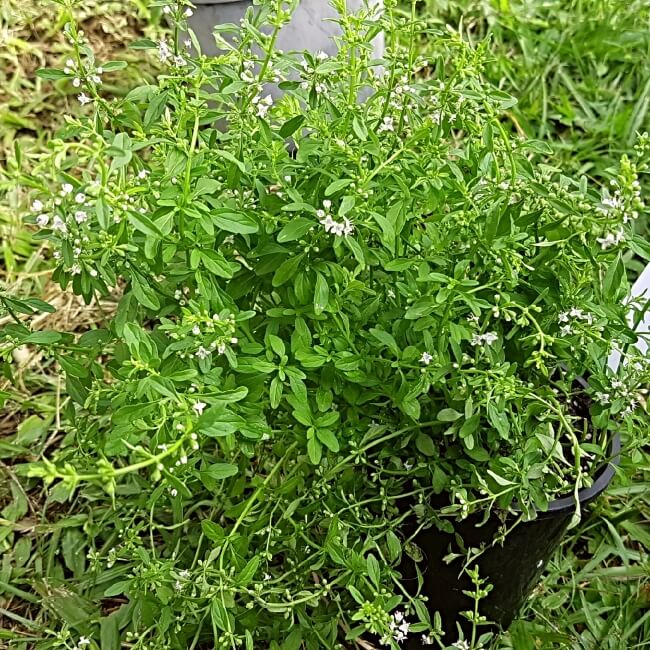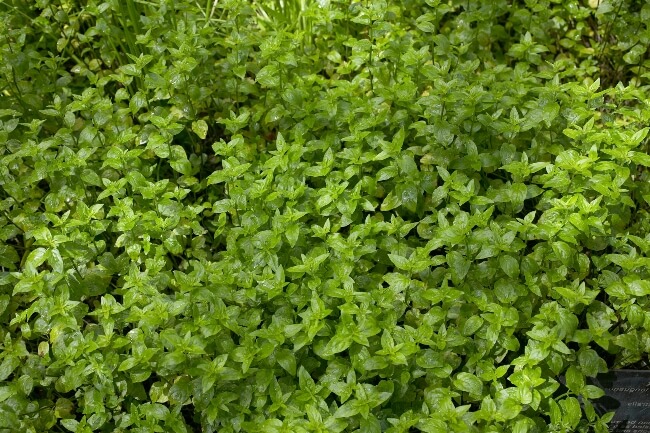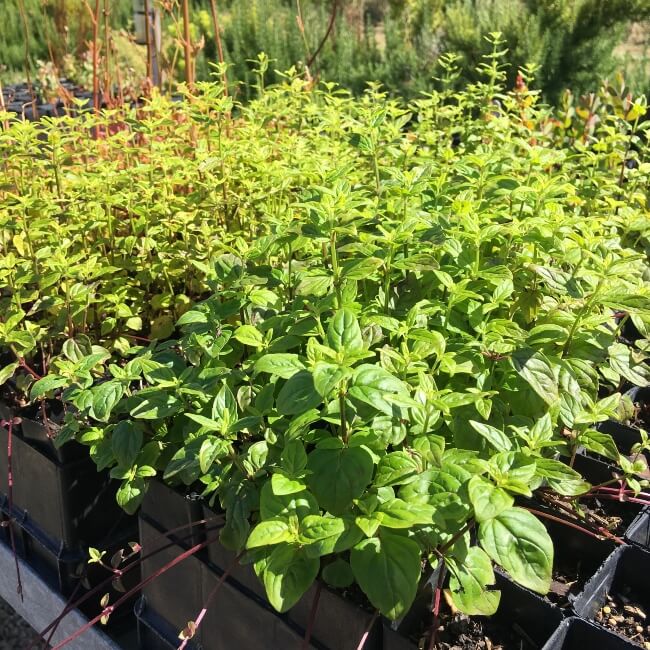Peppermint and spearmint might be the headliners of the mint world, but Australia’s own native mint, also called river mint, is an outstandingly easy herb to grow and looks wonderful in pots and window boxes wherever it is planted.
If you have ever wanted to grow this perennial herb but don’t know where to start, or are worried about it spreading, then this is the guide for you. We have practical tips on planting, dividing, and caring from this brutish beauty, so you can grow it with peace of mind, and be harvesting for your own summer drinks in no time.
More...

Source: GardenTags
Family: | Lamiaceae |
|---|---|
Genus: | Mentha |
Species: | M. australis |
Common Names: | Native mint, River mint, Wild mint |
Origin: | Eastern Australia |
Location: | Outdoor or indoor |
Type: | Herb |
Growth: | 50 cm tall, spreading |
Sun requirements: | Full sun, part shade, full shade |
Foliage Colour: | Green |
Flower Colour: | White |
Flowering: | Summer |
Edible Parts: | All edible |
Maintenance level: | Low |
Poisonous for pets: | Non-toxic to cats and dogs |
What is River Mint?
River mint is a member of the mint family, Mentha, but its flavour and appearance are both notably different. In terms of flavour, river mint is closer to spearmint than other common mints, but much sweeter, and with a lingering fragrance.
Texturally, river mint is distinctly smooth, with foliage more like basil than mint. The smooth leaves have no serrations, and no fluffiness, making them melt-in-the-mouth delicious and perfect for cocktails.
Botanically speaking, river mint is a herbaceous perennial, with spreading roots and the ability to root from fallen stems. It reaches a maximum of 50 cm tall but is typically closer to 30 cm in bright conditions, and can spread to fill unlimited spaces.
River Mint’s Natural Habitat
River mint, or Mentha australis, is Australia’s own wild mint. It is native to Eastern Australia and found growing wild throughout the country, in all parts other than WA.
It grows alongside rivers and in damp, shaded forests. Essentially, anywhere damp. As such, you will need to water your river mint regularly to make sure its leaves have the best bite and the most reliable flavour.
How to Grow River Mint
River mint can be grown in nearly any conditions, but it does need regular watering if grown on sandy soil, or in containers. That means it can be grown just as easily indoors as it can be grown outdoors, and makes for a simple and high-impact kitchen windowsill herb to impress your guests.
Plus, you can give them cuttings as gifts to help maintain it (a great all-round party plant!).

Source: The Australian Superfood Co
Growing River Mint Indoors
Growing river mint indoors is incredibly simple, just pop a few small plants into a standard potting mix in a container of your choice (go for something with a matching tray beneath as it will need regular watering, and won’t mind sitting in water for a day or two).
Choose a pot that is about twice the size of its current root ball as it will quickly grow to fill the space, and roots will send up new shoots regularly.
There is no need to place river mint in a bright window, but it will happily cope with it. If you have a dark kitchen, it can grow with minimal light, and can even grow in full shade if necessary.


Get Your Free Guide:
Master Growing Australian Natives eBook
A Must Have Complete Guide for Every Australian Garden
Get Your Free Guide:
Master Growing Australian Natives eBook
A Must Have Complete Guide for Every Australian Garden
Note: Regularly cut back even if you don’t need to harvest, as the younger, fresher, growth has the best flavour.
How to Grow Mentha australis Outdoors
Our top tip for growing river mint outdoors is to control it. It sounds simple, but it really isn’t. River mint is one of the most vigorously rooted plants there is, even within the mint family.
It will seek out soil with its trailing roots, so even if you grow it in a container, the roots can escape over the sides, or from drainage holes to find the soil.
Thankfully, other than that, there is little else to worry about when growing river mint outdoors. It can be grown in containers, or on the ground (with plastic sheets around the plant to limit root spread), in any soil type.
River mint will grow in full sun or full shade, and anything in between, and despite preferring plenty of moisture, it is surprisingly drought tolerant so very hard to kill.
Note: We grew our first river mint here in a large ceramic pot, on a paved patio, against a wall, with a pond between it and any soil. The roots escaped from the pot, and travelled under the pond, to root on the other side! Regular management is a must for river mint in any location.
How to Control River Mint
Window boxes and hanging baskets are the most reliable way to control river mint. The only challenges in these conditions are extra watering as they will both drain faster than standard pots, or mint grown in the ground.
The benefits are easily manageable river mint that will trail and add drama to any situation with minimal management needed.
How to Propagate River Mint
The real heading here should, perhaps, be ‘How not to propagate river mint’. Basically, if you leave river mint to its own devices, it will propagate itself, either into new plants or by producing seed from its gorgeously delicate flowers.
Both are manageable, and both can be taken advantage of if you’d like to expand your collection.

River Mint Propagation from Seeds
Growing river mint from seed couldn’t be simpler. Just harvest dried seed when the flowers have faded, and sprinkle it straight into 10 cm pots filled with whatever compost you have available. Water it well, and leave it somewhere bright for a couple of weeks and germination should be automatic.
After a few weeks, thin out the seedlings to about five per pot, and pinch out the growing tips to create busier plants. Within a couple of weeks, you will have garden-ready river mint plants.
Note: You can sow river mint at any time of year, but midsummer gives the best results. Leave pots in part shade to germinate and keep them moist.
Propagating Mentha australis from Cuttings
River mint, like any other mint variety, can be propagated easily from cuttings. Simply cut back a few stems and drop them into a glass of clean water (tap water is fine).
After 7-14 days, roots should be clearly visible, and your cuttings can be potted into clean compost to grow on. When new growth starts and roots have filled the pot, they are ready for the garden.
Mint roots from all nodes, regardless of the direction it is laid on the ground, so there is no need to fuss about removing leaves or cutting at certain points. The more the stem is submerged, the more points it will root from.
Propagating River Mint from Division
If your river mint has got a little bit carried away in the garden, just divide it. The whole clump can be chopped up and thrown on the compost heap (turning regularly will eventually kill it and it will produce excellent compost), or you can place the divided section into its own pot and plant it elsewhere in the garden, or give it to a friend.
Caring for River Mint
River mint requires very little ongoing care. There is no need to mulch it, as river mint prefers slightly drier winters if anything, and during summer, the mulch can lead to fungal problems around the base of the plant.
The only regular care tips for river mint are to water regularly and regularly divide river mint if it is planted in the ground.
For potted river mint, simply lift and split any plants, and either flip them to the outside facing inwards (this prevents hollow centres) or discard one half to give the other space to grow.
River Mint Pests and Diseases
There are not many pests that would brave river mint. The flavour and aroma of mint of all types is a common pest deterrent but there are some mite species that will take up residence on vigorous mint plants.
On the whole, river mint is pest and disease-free as long as it isn’t sitting in stagnant water.
How to Harvest and Prepare River Mint
Identifying River Mint
River mint is simple to identify. Visually, it will be growing in damp conditions, in large clumps, with leaves that look like common mint, but softer, like basil. When crushed, or brushed against, it will have an intense menthol fragrance.
If you are unsure, crush and bite down on a few leaves. The minty flavour is unmistakable and distinguishes river mint from other plants that may be unsafe to forage.
Harvesting and Using River Mint
Every part of river mint is edible, but it is the fresh young leaves that make the best ingredient and pack the most flavour. Picking the small leaves at the tips of river mint plants can be done at any time of the year, and helps to promote new growth – actually increasing the growth in the long term by regularly harvesting it.
Once picked, river mint can be dried for storage by hanging stems upside down until the stem snaps. Dry leaves can then be stored in airtight jars for several years.
To eat fresh, chop river mint for use in sauces, infusions, and cake batters, or use whole leaves in hot teas.
Mentha australis Frequently Asked Questions

Source: Castlemaine Flora
Is River mint the same as water mint?
River mint is not the same as Water mint. Water mint, or Mentha aquatica, is native to Europe, Africa and Asia, and grows with its roots submerged. Its foliage is tougher than river mint.
Both are herbaceous perennials in the mint family and share similar flavours, but do not share interchangeable growing conditions.
What is river mint good for?
River mint is particularly useful as an infusing herb for cocktails and cold drinks. Its texture is smoother than most mints, and the fine leaves just melt in the mouth.
What are the medicinal uses of river mint?
River mint is often used as a herbal remedy thanks to its long-understood medicinal properties, particularly focussed on gut soothing and supporting the relief of heartburn or indigestion.
What mint is the best substitute for river mint?
If you can’t get hold of river mint, Vietnamese mint shares a similar flavour profile and vaguely similar texture to river mint. River mint is slightly less fussy about its growing position though, so if you can find river mint plants for sale, that’s still, definitely, the one to go for.
What does river mint smell like?
River mint is close to spearmint in its flavour and fragrance, thanks to a general sweetness, but its fragrance is longer lasting.
Is Australian native mint invasive?
River mint is a native Australian mint so not invasive in our country. However, it is very much invasive in our gardens and will take over borders if left unchecked, so plant river mint in pots and containers to restrict its spread.
What soil does river mint prefer?
River mint prefers moisture-retentive soils but can grow in any soil conditions. Even loose, deep sand can sustain river mint if you add a little bit of organic material to the planting hole and water regularly.
How should I prune my river mint?
Rive mint is easy to prune. Just cut it back as often as you remember. For perfect results and the longest possible harvest, leave it to flower first, then cut back the whole plant to encourage fresh new growth.
Then, in late summer, cut back half the plant so you get a final flush of fresh foliage, but can keep harvesting the older growth through the start of autumn.
Wrapping Up Our River Mint Growing Guide
River mint is possibly one of the easiest native plants to grow in Australia. It will grow in nearly all Australian climates and on nearly all Australian soils. While it can be temperamental if it is allowed to dry out, it is drought tolerant and can recover very quickly after heat waves with good and generous watering.
If you’re considering growing river mint for yourself, I strongly recommend it. It’s easy, it’s flavourful, and its deliciously light texture makes it a wonderful kitchen herb. Just make sure you know that growing river mint means controlling river mint.
Published on January 12, 2025 by Gary Clarke
Last Updated on December 5, 2025




